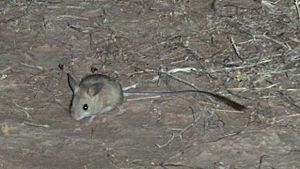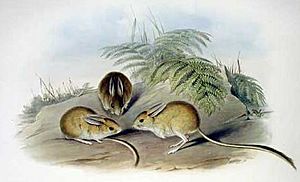Fawn hopping mouse facts for kids
Quick facts for kids Fawn hopping mouse. |
|
|---|---|
 |
|
| Conservation status | |
| Scientific classification | |
| Genus: |
Notomys
|
| Species: |
cervinus
|
The fawn hopping mouse (Notomys cervinus) is a small rodent that lives in the central Australian desert. It's known for its long hind feet, which help it hop around like a tiny kangaroo! These mice are special because they don't need to drink water. They get all the moisture they need from their food.
Contents
About the Fawn Hopping Mouse
The fawn hopping mouse is a unique creature. Like all hopping mice, it has strong front teeth. It also has a long tail and big, dark eyes. Its ears are quite large, and its hind feet are very long and narrow. These feet help it move quickly across the desert.
What Does It Look Like?
This mouse weighs between 30 and 50 grams. To compare, a common house mouse weighs only 10 to 25 grams. Its fur can be a pale pinkish-fawn color. Some mice are more grey on their upper parts. Their underside is always white.
The tail is about 120 to 160 millimeters long. It has two colors: white underneath and darker on top. The tail also ends in a dark brush, like a tiny paintbrush. Its large, round, dark eyes and big ears stand out. Even its whiskers are long, reaching up to 65 millimeters! This is impressive for a mouse that is only 95 to 120 millimeters long.
Where Does It Live?
The fawn hopping mouse prefers dry, open areas. Its favorite home is in the gibber plains. These are flat, stony deserts with very few plants. It also lives in claypans, which are dry, flat areas of clay. You can find them in parts of northern South Australia. They also live in far south-western Queensland. It's possible they live in the Northern Territory, but this is not certain.
Long ago, in the late 1800s, these mice lived in more places. Their former home included western New South Wales.
Life and Habits
Fawn hopping mice live in small family groups. Each group usually has two to four mice. During the day, they stay safe in their burrows. These burrows are simpler than those of other hopping mice. They are also shallower, but can still be up to a meter deep. Each burrow has one to three entrances.
At night, these mice come out to find food. They can travel hundreds of meters from their burrow. They mostly look for seeds. If they find them, they will also eat green shoots and insects. Like other hopping mice, they don't need to drink water. They can even use salty water if that's all that's available.
Reproduction
Scientists believe these mice breed when conditions are good. This often happens after it rains. In places where they are kept and studied, pregnancy lasts about 40 days. After this time, one to five young mice are born. The babies are born with fur already.
Why Is It Special?
The fawn hopping mouse is currently classified as vulnerable. This means its numbers are decreasing. The reasons for this decline are not fully known. However, scientists think a few things might be causing it. One reason is that their habitat is changing. Another is competition for food with introduced species. These are animals brought to Australia from other places. Finally, predators like introduced cats and foxes also hunt them.

See also
 In Spanish: Notomys cervinus para niños
In Spanish: Notomys cervinus para niños


